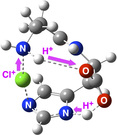1. Application of Quantum Chemical Methods to Problems of Biochemical Relevance.
We have a long standing interest in applying state-of-the-art
computational modeling (DFT and ab initio methods) to elucidate the
catalytic mechanisms in salient organic, organometallic and enzymatic
systems. Two recent representative examples are:
2. Application of Quantum Chemical Methods to Graphene catalysis.
3. Development of Ab Initio Composite Thermochemical Methods. Together with Jan M. L. Martin (Weizmann Institute of Science), we develop ab initio composite methods employing successively higher cluster expansion terms in conjunction with basis set extrapolation techniques and explicitly correlated methods (most notably, W1-F1[2,3] W3.2lite[4] and W4[5] theories). W1-F12 theory, which exploits the fast basis set convergence of explicitly-correlated methods, represents a major step forward as it is capable of unprecedented accuracy in thermochemical predictions for systems as large as corannulene and for systems of biological relevance (e.g., amino-acid residues and DNA bases).
References:
(1) Karton, A.; O’Reilly, R. J.;Pattison, D. I.; Davies, M. J.; Radom, L. J. Am. Chem. Soc. 2012, 134, 19240.
(2) Nagy, P.; Karton, A.; Betz, A.; Peskin, A. V.; Pace, P.; O’Reilly, R. J.; Hampton, M. B.; Radom, L.; Winterbourn, C. C. J. Biol. Chem. 2011, 286, 18048.
(3) Karton, A.; Martin, J. M. L. J. Chem. Phys. 2012, 136, 124114.
(4) Karton, A.; Kaminker, I.; Martin, J. M. L. J. Phys. Chem. A 2009, 113, 7610.
(5) Karton, A.; Rabinovich, E.; Martin, J. M. L.; Ruscic, B. J. Chem. Phys. 2006, 125, 144108.
(6) Karton, A.; O’Reilly, R. J.; Chan, B.; Radom, L. J. Chem. Theory Comput. 2012, 8, 3128.
(1) Karton, A.; O’Reilly, R. J.;Pattison, D. I.; Davies, M. J.; Radom, L. J. Am. Chem. Soc. 2012, 134, 19240.
(2) Nagy, P.; Karton, A.; Betz, A.; Peskin, A. V.; Pace, P.; O’Reilly, R. J.; Hampton, M. B.; Radom, L.; Winterbourn, C. C. J. Biol. Chem. 2011, 286, 18048.
(3) Karton, A.; Martin, J. M. L. J. Chem. Phys. 2012, 136, 124114.
(4) Karton, A.; Kaminker, I.; Martin, J. M. L. J. Phys. Chem. A 2009, 113, 7610.
(5) Karton, A.; Rabinovich, E.; Martin, J. M. L.; Ruscic, B. J. Chem. Phys. 2006, 125, 144108.
(6) Karton, A.; O’Reilly, R. J.; Chan, B.; Radom, L. J. Chem. Theory Comput. 2012, 8, 3128.


